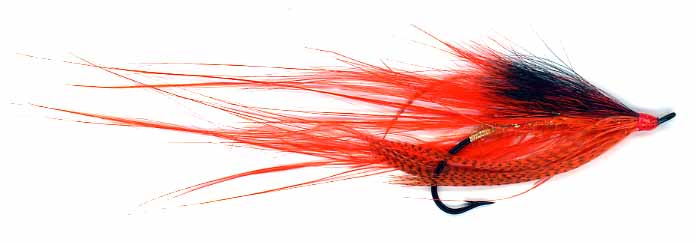The Strathspey, a Nova Scotia Fly for Fall Salmon
Spey flies originated in Scotland long ago, as long as 2 centuries. They are simple flies that we think were designed to
imitate shrimp, or prawns as the British call them, and they were very effective salmon flies. They have taken their name,
as have Spey rods and Spey casting, from Scotland’s beautiful Spey River.
Most Spey flies were tied on long-shanked light-wire hooks designed for these flies. They were sparsely dressed with long,
flowing hackles and a flat bronze mallard wing – great imitations of the legs and feelers of a shrimp with a shell back.
Above all, these flies had a terrific lifelike action in the salmon pools of olden times.
Like Spey rods and Spey casting, Spey flies are currently enjoying a renaissance for fall salmon fishing on Nova Scotia
rivers. The Strathspey uses the traditional characteristics of these Scottish flies and feature bright shades of orange that
are irresistible to our salmon when frost covers the fields and the rivers run clear and cold.
Long ago these flies were hackled with long-fibered heron feathers, but today we have readily available legal substitutes
like turkey marabou, cock schlappen, or the wonderful new Whiting Spey Hackle (now
available from River Magic's website store). The Strathspey also substitutes squirrel tail tied flat
and low for a wing, rather than bronze mallard for three reasons – the material is readily available, is easier to tie,
and has a proven record on salmon. The counter-rib of the traditional Spey is retained because it protects hackle stems and
makes the fly more durable. Our new synthetic Ice Dub makes a great body substitute for dubbings of seal fur or pig’s
wool.
Here’s a recipe for Nova Scotia’s Strathspey that produces a very traditional looking
Spey fly using new and improved materials.
The Strathspey
Thread:
UTC G.S.P. 50 Denier red thread
Hook:
Partridge Bartleet Traditional Salmon hook, size 1-2/0
Tag:
Gold Holographic Flatbraid
Tail:
None
Rib:
Silver Sparkle Braid
Counter Rib:
Gold Holographic Flatbraid
Body:
Orange Ice Dub
Body Hackle 2
orange spey hackles
Hackle:
Mallard flank dyed orange
Wing:
Grey squirrel tail dyed hot orange
Head:
Red thread finished with 2 coats Angler’s Corner Wet Head Cement
Enjoy your fishing
and please stay on the line …
